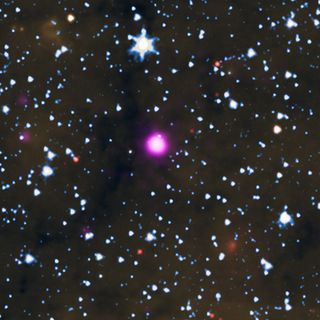Astronomers spot the fastest spinning magnetar ever seen
It might be the youngest ever, too.
Far-off in the Milky Way galaxy, 21,000 light-years from Earth, astronomers have spotted the fastest-spinning magnetar (and possibly youngest, too) ever seen. And that's just the start of what makes this star strange.
Magnetars are a unique type of neutron stars, which are the collapsed cores of supergiant stars that died in supernova events. What sets magnetars apart from other neutron stars is that they possess extremely powerful magnetic fields — he most powerful ones in the known universe, in fact. They can also explode without warning and are fairly difficult to spot. In fact, before this object was discovered, there were only 30 known magnetars, compared to the thousands (approximately 3,000) known neutron stars.
Now, scientists studying the skies with NASA's Chandra X-ray Observatory — a space telescope that looks out at black holes, supernovas and more — think that a newly discovered magnetar known as J1818.0-1607 could be the fastest-spinning and possibly also the youngest magnetar known, according to a statement. They also found a myriad of other odd things that make this object truly unique.
Gallery: Amazing Photos by NASA's Chandra X-Ray Observatory

Astronomers first spotted this magnetar on March 12, 2020 with NASA's Neil Gehrels Swift Telescope. Later on, Harsha Blumer, an astronomer at West Virginia University, and Samar Safi-Harb, a physics professor at the University of Manitoba in Canada, observed the magnetar using Chandra, and they noticed a couple of peculiar things that made the magnetar stand out.
One of the first things that seemed intriguing about this particular object was how young it appeared. The team estimated that the magnetar is about 500 years old, which, if true, would make it the youngest discovered yet. They determined the object's age by measuring how quickly the rotation rate of the magnetar is slowing down (it spins slower over time) while assuming that the object started out spinning much faster.
The second thing that really stood out to the team was just how fast the object was spinning, as it seemed to be rotating once fully every 1.4 seconds (which is really, really fast).
Get the Space.com Newsletter
Breaking space news, the latest updates on rocket launches, skywatching events and more!
Other astronomers have taken a look at J1818.0-1607 as well, observing the magnetar using radio telescopes like the National Science Foundation's Karl Jansky Very Large Array (VLA) and have found that it's emitting radio waves, a quality it shares with objects known as "rotation powered pulsars." These are a type of neutron star that emits radiation that we on Earth detect as "pulses" of radio wave emissions.

Blumer and Safi-Harb also found that the magnetar isn't converting spinning energy from its rotations into X-ray emissions as efficiently as expected for a magnetar. In fact, the object is converting this energy at a rate most common with rotation-powered pulsars, another interesting commonality between the two objects.
The last odd thing that the pair of researchers found about this young, fast star was that, while most magnetars around this age would have left behind a debris field of material leftover from the supernova that created the object, the researchers only found possible evidence of a supernova remnant with J1818.0-1607, and this debris was pretty far from the object.
By their estimations, in order for the debris field to have traveled that far away from the magnetar, the object would've needed to have traveled at speeds faster than ever seen with a neutron star.
This work was accepted for publication in the Astrophysical Journal Letters.
Email Chelsea Gohd at cgohd@space.com or follow her on Twitter @chelsea_gohd. Follow us on Twitter @Spacedotcom and on Facebook.
Join our Space Forums to keep talking space on the latest missions, night sky and more! And if you have a news tip, correction or comment, let us know at: community@space.com.

Chelsea “Foxanne” Gohd joined Space.com in 2018 and is now a Senior Writer, writing about everything from climate change to planetary science and human spaceflight in both articles and on-camera in videos. With a degree in Public Health and biological sciences, Chelsea has written and worked for institutions including the American Museum of Natural History, Scientific American, Discover Magazine Blog, Astronomy Magazine and Live Science. When not writing, editing or filming something space-y, Chelsea "Foxanne" Gohd is writing music and performing as Foxanne, even launching a song to space in 2021 with Inspiration4. You can follow her on Twitter @chelsea_gohd and @foxannemusic.
